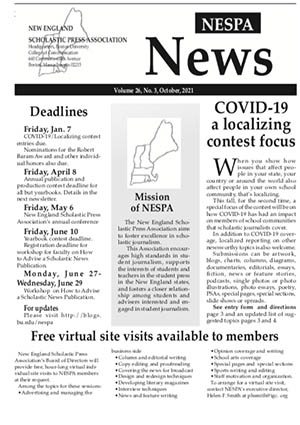Realistic planning, simplicity work best, its creator says
by Anna Zembo
Building a website for a high school news publication takes careful planning, said Carissa Broadbent, the technical coordinator of The Villager at Westport High School in Westport, Mass.
“The first thing to think about is what you want your website to do,” said Broadbent, a junior. “Your website needs to be clear and easily navigable.
“Don’t get caught up in the bells and whistles, and don’t let them be your priority. Simple is better—at least to start.”
Broadbent gave a presentation Friday, April 30 at the New England Scholastic Press Association’s 62nd annual conference at Boston University.
She said that with many exciting programs available, it can be tempting to dive straight into the process.
“Stay away from the computer at first and make a list of what you need,” she said.
“Then sketch your site design on paper. Keep away from drastic color schemes. You want it to be easy on the eyes because people are reading a large volume of text. The biggest thing is function over fashion.”
Tools and programs can make building a website a little less daunting, she said.
“HTML and CSS put things on the screen and style them,” she said. “HTML is the most basic language of the Internet.
“It puts text, images, containers on the screen. It is also entirely manual. It doesn’t do anything, just shows things.
“CSS is a way of stylizing web pages. It doesn’t print things to the screen the way HTML does, but it styles HTML so you don’t have to do it manually.
“For example, in my CSS file I could say that I want my text to be white and my background to be black, and I could set the height of a certain container ID.
“Once I link the CSS file to the HTML file, I can apply those specifications to all the pages in my website, and if I decide to change my layout, all I have to do is change my CSS file.
“If I were just using HTML, I would have to specify each attribute in each webpage manually, and changing the look of the website would be hugely tedious.”
PHP is what makes a website tick, Broadbent said.
“Aside from text, it can’t put things on the screen, but it does put the engine on your website,” she said.
“For example, it is what will take the stories you post and place them on the homepage in the correct order. If you had no PHP for your newspaper site, you would have to enter every story by hand into its own HTML document. There would be no automation and the website would simply be unmanageable.
“Wordpress, a content management system, is the skeleton of the website. It is a fantastic platform for newspaper websites because it can handle and organize large quantities of stories/posts, with lots of flexibility.”
Although creating a website takes time, Broadbent encouraged students not to be intimidated in the process of seeking answers to their questions.
“A website is made out of boxes,” Broadbent said. “It’s pretty simple, but it is a whole lot more complicated than it ought to be because technology is irritating.
“Keep in mind that you have to use what’s available to you. I chose to make my own theme to make it more individual. Google is your friend. Any problem you have you can find a solution to it.
“I have spent hours on this,” Broadbent said. “It’s never the stuff you think will take forever that’ll take you that long. Things like spacing things and aligning things can take you three or four hours.”
In terms of the transition for newspapers from print to the web, Broadbent said that the more content that goes into print, the easier the jump will be into cyberspace.
“The Villager is known as a print paper,” Broadbent said. “Once we get this online it will be an easy transition because we’re already going crazy to meet daily deadlines as it is.”
A question facing student online publications is whether to include reader feedback in the form of comments on the material posted.
“I’m not a fan of allowing comments because it’s a lot of work to filter them,” Broadbent said. “When people get really casual, it can get out of hand in comments. I’m thinking of having a sidebar with a form to link to e-mail comments. We can have a part that has student opinions that are more refined.”
Broadbent also reminded students that the job of creating website is never finished. She said it is important for the creators of a site to keep in mind the people who will be managing it after they are gone.
“A website is always a work in progress,” she said. “There are always things that need to be changed even once it’s up.
“You need to have it easily accessible for the next generation of reporters.
“This website can’t implode after I leave. It needs to go on after, so it needs to be straightforward.”
Anna Zembo is a reporter for The Villager at Westport High School in Westport, Mass.

